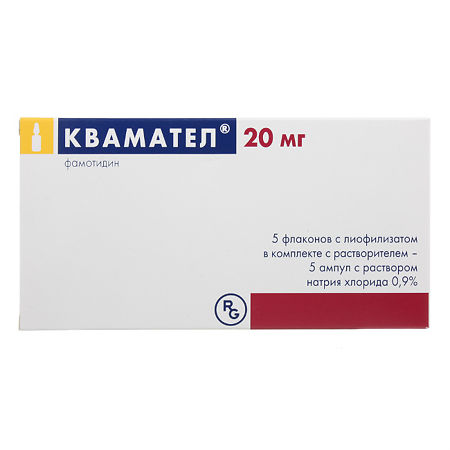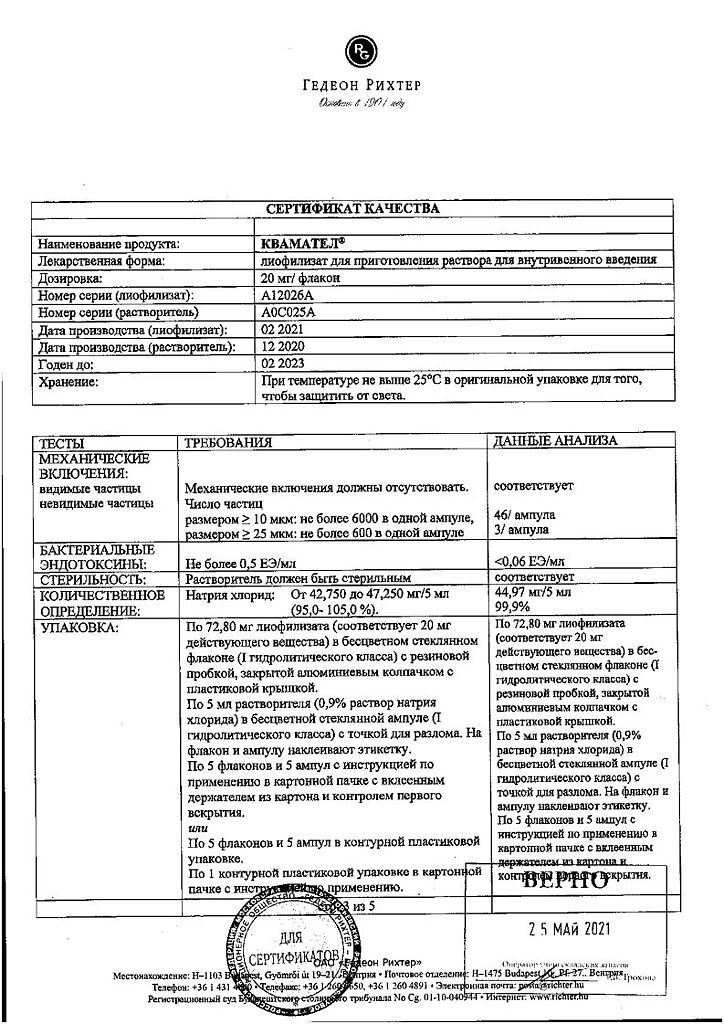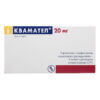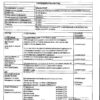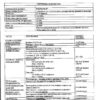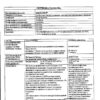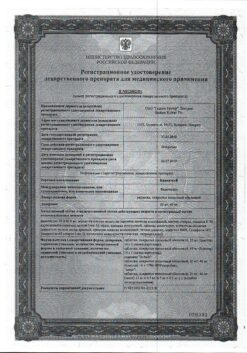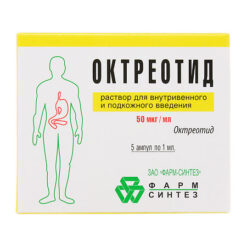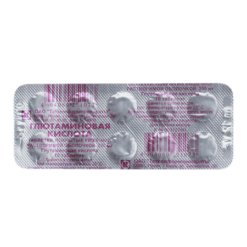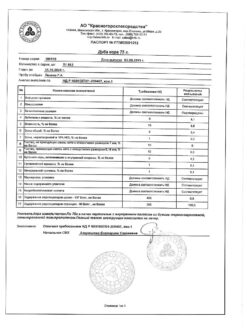No products in the cart.
Quamatel, lyophilizate 20 mg 5 pcs
€1.00
Out of stock
(E-mail when Stock is available)
Description
Quamatel is a blocker of histamine H2-receptors. It reduces basal and stimulated by gastrin, pentagastrin, betazol, caffeine, histamine, acetylcholine and physiological vagus reflex secretion of hydrochloric acid.
The pH increases and pepsin activity decreases. Virtually no effect on gastrin levels on an empty stomach and after meals. It does not affect gastric motility, exocrine activity of the pancreas, blood flow in the portal system, hormone levels, and has no antiandrogenic effect.
Famotidine has little effect on microsomal liver enzymes. After oral intake the action comes within 1 hour, maximum of action – 3 hours after intake, the duration of effect varies within 12-24 hours, depending on the dose. The drug in the form of lyophilisate for preparation of a solution for intravenous injection after administration of a single dose of 20 or 40 mg in the evening suppresses basal and nocturnal secretion for 10-12 hours.
Pharmacokinetics in special clinical cases In CC. Pharmacokinetics Pharmacokinetics is linear. Absorption After oral administration is not completely absorbed from the gastrointestinal tract. Cmax is reached after 1-3 hours and is 0.07-0.1 mg/L. Bioavailability is 40-45%; it increases with simultaneous food intake and decreases with simultaneous use of antacids.
Distribution Binding to plasma proteins is 10-20%. It penetrates through the placental barrier and through the HEB. It is excreted with breast milk. Metabolism 30-35% of the drug is metabolized in the liver to form S-oxide. Excretion T1/2 is 2.3-3.5 hours. After oral administration 30-35% of famotidine, and after intravenous administration 65-70% of famotidine is excreted unchanged in the urine.
Indications
Indications
Peptic ulcer of the duodenum and stomach in the acute phase, prevention of relapses.
Treatment and prevention of symptomatic gastric and duodenal ulcers (associated with the use of nonsteroidal anti-inflammatory drugs (NSAIDs), stress, postoperative ulcers).
Erosive gastroduodenitis.
Functional dyspepsia associated with increased secretory function of the stomach.
Reflux esophagitis.
Zollinger-Ellison syndrome.
Prevention of recurrent bleeding from the upper gastrointestinal tract.
Prevention of aspiration of gastric juice during general anesthesia (Mendelssohn syndrome).
Pharmacological effect
Pharmacological effect
Kvamatel is a histamine H2 receptor blocker. Reduces basal and stimulated by gastrin, pentagastrin, betazol, caffeine, histamine, acetylcholine and the physiological vagal reflex secretion of hydrochloric acid.
At the same time, pH increases and pepsin activity decreases. Has virtually no effect on fasting and postprandial gastrin levels. Does not affect gastric motility, exocrine activity of the pancreas, blood circulation in the portal system, hormone levels, and does not have an antiandrogenic effect.
Famotidine has little effect on liver microsomal enzymes. After taking the drug orally, the effect occurs within 1 hour, the maximum effect occurs 3 hours after administration, the duration of the effect ranges from 12-24 hours, depending on the dose. The drug in the form of a lyophilisate for the preparation of a solution for intravenous administration after administration in a single dose of 20 or 40 mg in the evening suppresses basal and nocturnal secretion for 10-12 hours.
Pharmacokinetics in special clinical cases With CC. Pharmacokinetics Pharmacokinetics is linear. Absorption After oral administration, it is not completely absorbed from the gastrointestinal tract. Cmax is reached after 1-3 hours and is 0.07-0.1 mg/l. Bioavailability – 40-45%, increases with simultaneous food intake and decreases with simultaneous intake of antacids.
Distribution Plasma protein binding is 10-20%. Penetrates through the placental barrier and through the BBB. Excreted in breast milk. Metabolism 30-35% of the drug is metabolized in the liver to form S-oxide. Excretion T1/2 is 2.3-3.5 hours. After oral administration, 30-35% of famotidine, and after intravenous administration, 65-70% of famotidine is excreted unchanged in the urine.
Special instructions
Special instructions
The use of Kvamatel can mask the symptoms of stomach cancer, therefore, before starting treatment with famotidine, it is necessary to exclude the presence of a malignant neoplasm.
In patients with impaired liver function, Kvamatel should be prescribed with caution and in lower doses. If treatment is abruptly stopped, famotidine may cause withdrawal syndrome, so treatment is stopped, gradually reducing its dose.
With long-term treatment of weakened patients or patients under stress, bacterial damage to the stomach is possible with further spread of infection. Kvamatel should be taken 2 hours after taking itraconazole or ketoconazole to avoid a significant decrease in their absorption. You should also observe a 1-2 hour break between taking Kvamatel and antacids.
Impact on the ability to drive vehicles and operate machinery
During the period of taking the drug Kvamatel, patients should be careful when driving vehicles and engaging in potentially hazardous activities that require increased concentration and speed of psychomotor reactions. Histamine H2 receptor blockers (including Kvamatel) can inhibit the acid-stimulating effect of pentagastrin and histamine, so Kvamatel should be discontinued 24 hours before the test.
During treatment, you should avoid consuming foods, drinks and other medications that may irritate the gastric mucosa. Histamine H2 receptor blockers may suppress the skin response to histamine, thus leading to false negative results.
Therefore, before performing diagnostic skin tests to detect an immediate allergic skin reaction, Kvamatel should be discontinued.
Active ingredient
Active ingredient
Famotidine
Composition
Composition
1 bottle contains:
Active substance:
famotidine 20 mg;
Excipients:
aspartic acid;
mannitol;
sodium chloride;
water for injections.
Pregnancy
Pregnancy
The drug is contraindicated for use during pregnancy.
If it is necessary to use the drug during lactation, breastfeeding should be discontinued.
Contraindications
Contraindications
Hypersensitivity to famotidine and other H2-histamine receptor blockers, pregnancy, lactation, childhood.
WITH CAUTION
Hepatic or renal failure, liver cirrhosis with a history of portosystemic encephalopathy.
Side Effects
Side Effects
From the digestive system: dry mouth, nausea, vomiting, abdominal pain, flatulence, constipation, diarrhea, loss of appetite; increased activity of liver transaminases, hepatocellular, cholestatic or mixed hepatitis, acute pancreatitis.
Allergic reactions: urticaria, skin rash, itching, bronchospasm, angioedema, anaphylactic shock.
From the hematopoietic system: very rarely – agranulocytosis, pancytopenia, leukopenia, thrombocytopenia, bone marrow hypo- or aplasia. From the musculoskeletal system: arthralgia, muscle spasms.
Dermatological reactions: alopecia, acne vulgaris, dry skin, toxic epidermal necrolysis.
From the central nervous system: headache, dizziness, drowsiness, hallucinations, confusion, fatigue, depression, agitation, anxiety.
From the senses: decreased visual acuity, tinnitus. From the cardiovascular system: arrhythmia, bradycardia, AV block, decreased blood pressure.
From the reproductive system: with long-term use in high doses – hyperprolactinemia, gynecomastia, amenorrhea, decreased libido. Other: fever.
Interaction
Interaction
Antacids and sucralfate, used simultaneously with Quamatel, slow down the absorption of famotidine.
Due to the increase in the pH of the gastric contents, Kvamatel, when used simultaneously, reduces the absorption of ketoconazole and itraconazole; increases the absorption of amoxicillin and clavulanic acid.
When taking Kvamatel and drugs that inhibit bone marrow hematopoiesis simultaneously, the risk of developing neutropenia increases.
Overdose
Overdose
Symptoms: tachycardia, motor agitation, vomiting, tremor, decreased blood pressure, collapse.
Treatment: gastric lavage, symptomatic and supportive therapy; hemodialysis.
Storage conditions
Storage conditions
In a place protected from light, at a temperature of 25 °C.
Shelf life
Shelf life
3 years.
Manufacturer
Manufacturer
Gedeon Richter, Hungary
Additional information
| Shelf life | 3 years. |
|---|---|
| Conditions of storage | In the dark place at 25 °C. |
| Manufacturer | Gedeon Richter, Hungary |
| Medication form | lyophilizate |
| Brand | Gedeon Richter |
Other forms…
Related products
Buy Quamatel, lyophilizate 20 mg 5 pcs with delivery to USA, UK, Europe and over 120 other countries.

